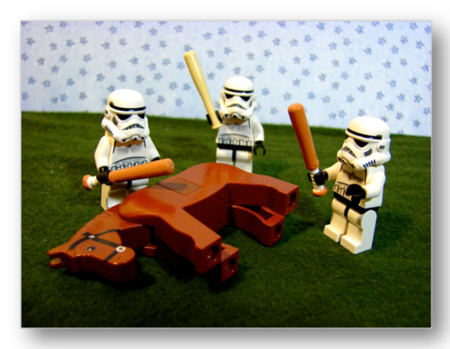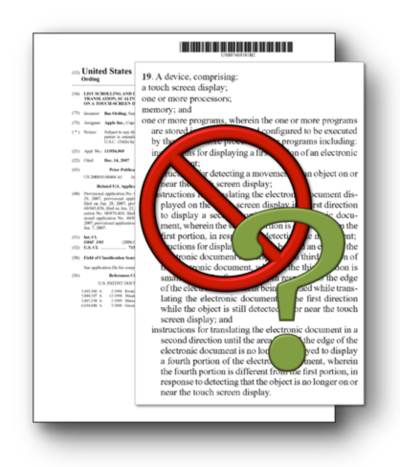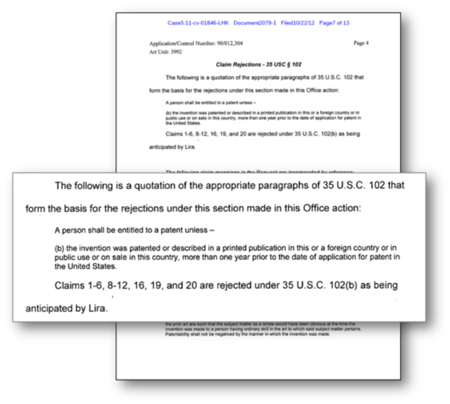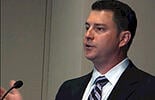 by Ryan H. Flax
by Ryan H. Flax
(Former) Managing Director, Litigation Consulting
A2L Consulting
It feels like I’m beating a dead horse, but there is obviously still some life left in the Apple v. Samsung patent case. Interesting things continue to develop since since I wrote about storytelling and the case going to the jury, the jury's verdict and the implications for design patents.
Last we left the Apple v. Samsung saga, the parties were arguing about damages enhancement and injunctions.
On Monday, Samsung filed a statement with the U.S. District Court in California informing the Court that the U.S. Patent and Trademark Office has just rejected claim 19 of U.S. Patent 7,496,381 as being unpatentable as anticipated by the prior art (actually, all 20 claims were rejected, but only claim 19 matters here).
The ‘381 patent is directed to the “screen bounce-back” feature of the “iProducts” and was one of the six Apple patents found infringed in the case. Claim 19 was the sole claim of the ‘381 patent at issue in the trial.
 Claim 19 of the ‘381 patent was rejected by an USPTO patent examiner in what’s called an ex parte reexamination, or “reexam” proceeding by those of us in the field. A reexam is a reopening of the USPTO’s patentability examination of an issued patent based on prior art. Normally, once a patent is granted (issued), the story is over.
Claim 19 of the ‘381 patent was rejected by an USPTO patent examiner in what’s called an ex parte reexamination, or “reexam” proceeding by those of us in the field. A reexam is a reopening of the USPTO’s patentability examination of an issued patent based on prior art. Normally, once a patent is granted (issued), the story is over.
However, either the patent-holder or some unknown, undisclosed party can file for a reexam if some new issue of patentability (prior art) is discovered after the patent is granted by the USPTO. The term “ex parte” means that even if some third-party provoked the reexam, after the reexam is instituted, only the USPTO and the patent holder are involved – the provoker (here, likely Samsung) gets out of the way.
The finding that a single claim is not patentable is not the same as finding an entire patent invalid. It means that that single claim is invalid (this is also how it is supposed to work at trial – on a claim-by-claim basis).
 This is not the first reexam for the ‘381 patent. There was another that concluded in April 2011 that found each of the claims, 1-20, patentable. But, as is clear, just because a patent has been through reexam once does not foreclose it happening again and with a different outcome.
This is not the first reexam for the ‘381 patent. There was another that concluded in April 2011 that found each of the claims, 1-20, patentable. But, as is clear, just because a patent has been through reexam once does not foreclose it happening again and with a different outcome.
The effect of this claim being found unpatentable is not yet clear. Samsung suggests that the ’381 patent is likely no longer infringed and that the new rejection should have an impact on the damages enhancement and potential injunction now at issue in the case. The reality is that we cannot be certain that this rejection will stand.
There is still an ongoing discussion between the USPTO examiner and Apple over the patentability of the patent claims. The rejection of claim 19 is not yet final. It is possible that Apple’s patent prosecution attorneys will convince the examiner that the rejection is incorrect and that it will be withdrawn. It also may be maintained finally and the claims cancelled by the USPTO.
It is likely, however, that this reexam rejection could affect the enhancement of damages to some degree. Enhanced damages in a patent case are awarded if the infringement is willful and determining willfulness is an objective test for the court to determine if the infringer had a reasonable belief that they weren’t infringing. The rejection of the ’381 patent’s claim 19 seems to establish that Samsung should have had a good faith belief that the claim wasn’t valid and, thus, that it didn’t infringe.
Since there are a bunch of other Apple patents not expressly in question by the USPTO and found infringed, it is doubtful that this even will sway the decision on injunction much. A product can be enjoined from importation or sale even if it only infringes one claim of the six patents-at-suit.
I’m eager to see if this horse gets up again. Let’s all stay tuned.
Find other patent litigation jury consulting, litigation graphics on trial technology discussions on A2L Consulting's site:
- A Patent Renaissance is Coming, Spurred by Apple's Design Patent Litigation
- Why Storytelling will Help Decide the Apple v. Samsung Case
- How Storytelling Helped the Jury Decide the Apple v. Samsung Case
- Educating Your Judge With Great Patent Tutorials in 30 mins or Less
- Download The Patent Litigator's Guide to Trial Presentation [free eBook]
- 11 Trial Graphics Tips for Patent Litigators from a Patent Litigator Turned Litigation Consultant
- 5 Surprises Turning from a Patent Litigator to a Trial Consultant






Leave a Comment